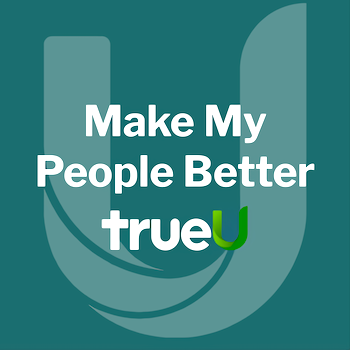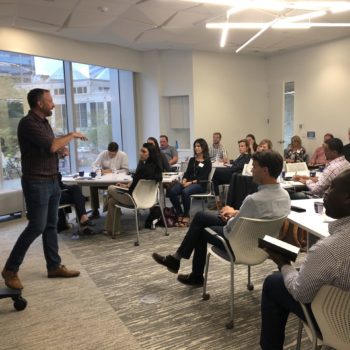Design thinking is a solution-based approach to problem solving that emphasizes practical, creative thought with the goal of developing the best possible solution. It really helps you get out of your comfort zone and find surprising solutions to difficult problems, and it’s what we use to engage with our clients—generating the ideas that eventually become the solutions for their unique challenges.
Our team was thrilled to host a design thinking overview session at the Colorado Lean Summit. During this lively session, we explained design thinking methodology and practiced applying principles such as being empathetic and brainstorming for ideation. Participants showed up engaged and ready to play, making it no surprise that at the conclusion of the session, we were challenged with some great questions. In this post, we share our thoughts surrounding their questions.
The arrogance of success is to think that what you did yesterday will be sufficient for tomorrow.
– William Pollard
1. Your first question might be, “What is design thinking?”
Design thinking is a deeply human process that taps into creative abilities we all have, but often overlook. It’s rooted in the belief that innovation starts with people—bringing them together and, most importantly, working to understand and meet their needs. The five-step process is focused first on understanding the challenge at hand and how it impacts those around it.
2. When conducting an empathy interview, is it okay to use our own experience to interpret and understand others’ experiences?
The answer to this question requires you to walk the line carefully. Two benefits come from shared experience. First, being able to share similar experiences can be a way to show vulnerability and build trust. Both are key to getting another person to open up and think deeply. Second, shared experiences can help you determine what questions to ask next or how someone might feel about their situation.
The key to referencing your own experience in an empathy interview successfully is to remember this simple fact:
It’s not about you.
It’s not about using another person’s experience to have your turn to talk. It’s not about taking another person’s situation and pattern matching a situation you have experienced. It’s simply not about you.
It is about deeply and fundamentally understanding the other person—their emotions, perspective, constraints (real and perceived), and beyond. In that way, sometimes shared experiences can get in the way. By keeping in mind that it’s not about you, you’ll do just fine.
3. How do you prioritize ideas during or post-brainstorming?
Brainstorming is a great way to gather ideas quickly during the ideate phase of design thinking. When you get so many ideas, how do you prioritize them? There are many techniques you can leverage. When prioritizing ideas, it’s important not to let consensus rule the day. Consensus tends to drive us back toward the status quo. Instead, make it someone’s job to gather feedback and make a decision. In the book, Sprint, a voting method is outlined where people silently place stickers on ideas they like best. Then, an identified leader is responsible for asking questions and making a decision. It’s a method that has worked for our team. What methods have worked for others?
4. At what point do the real constraints, such as budgets, come into the process?
Ah, yes, the tyranny of reality. It’s kind of a bummer!
At some point, you must understand that there are real constraints on your ideas and approaches. These include budget, schedule, team capability and capacity, etc. We encourage you to go through a few early-stage prototyping iterations before deciding what’s possible and what’s not. Remember, you’re working toward step-change innovations. Thinking too early about the traditional constraints will inhibit your thinking. In our experience, many traditional constraints either go away or can be overcome through the process of design thinking.
5. What is the best way to brainstorm: People talking, or people working independently?
We’ve found there are two camps: group brainstormers and silent brainstormers.
Group brainstormers love to talk it out, build energy through collaboration, and use the “yes, and…” methodology as a springboard for ideas. The challenge lies in overcoming common failure modes. For example, certain individuals (you know who you are) can dominate the conversation, either positively or negatively.
Silent brainstormers thrive off the fact that quality ideas increase when they have time to think and branch off. It allows individuals who are introverted to write and develop ideas they would never say in front of a group. The challenge with this approach is that people might not be as crazy as they need to be to work through the idea cycle (good – to bad – to great – to awful – to amazing).
Our solution? Find a great facilitator that incorporates different methods. Every group of people and every (redefined) problem is different. A great facilitator will blend everything together for success.
Watching groups brainstorm is always interesting. As polite humans, we often collaborate and attempt to gain consensus, which shows up as everyone talking and sharing ideas out loud. However, sometimes it’s best to have individual ideas flow into the group to find the synergy you seek.
A few tips:
- Selling your idea isn’t brainstorming
- Critiquing others’ ideas isn’t brainstorming
- Taking turns isn’t brainstorming
- Write everything down
- There are no bad ideas!
6. Where do we find more tools or methods to use?
Google is your friend here. There are several ways to learn more, specifically from Stanford d.school. There are quick courses, YouTube videos, and more.
If you are looking for a great overview guide to design thinking, we recommend Change by Design by Tim Brown.
7. How can governments apply the design thinking concept of fail fast?
We encourage you to fail fast, iterate, and just go do. In government, this can be an effective method to use when taking the first steps in a new program or way of delivering service.
Design thinking allows you to understand what needs to be done by failing quickly and adjusting and designing in new and innovative ways. Applying the principles of design thinking can result in a better citizen experience, more refined internal processes, and new service delivery methods; or, design thinking can simply reimagine government in an effective and quick-win way.
Conclusion
Our team is committed to using design thinking to guide our fearless problem solving. Our hope is that design thinking will lead you to a new way of tackling and understanding problems and finding innovative solutions to complex challenges.
Interested in learning more? Get in touch to hear more from our team about how we use design thinking to help solve our clients’ biggest challenges.
First published September 20, 2017. Updated September 28, 2023.
Share:
About the Author

Mark Caswell
Board Member @ Resultant
Mark Caswell led Resultant’s exceptional growth as CEO from 2019-23 and from 2014 onward served as a leader throughout the organization, including for the technology services and professional...
Read More






